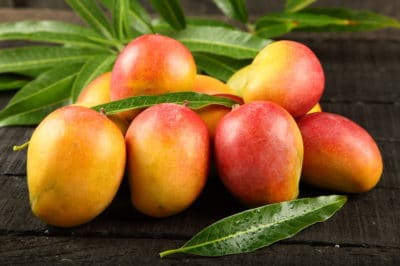Origin of Mangos
Mangos are native to the southern regions of Asia, especially in Burma, Andaman Islands and eastern sections of India, and have been cultivated and treasured since ancient times. It’s believed in the 4th and 5th Centuries B.C., Buddhists monks transported the fruit to portions of eastern Asia and Malaya.
In the 10th Century A.D., it’s thought the Persians introduced mangos to East Africa. By the time the early Portuguese arrived in the East Indies, mangos had already arrived, but they brought the fruit to the West Africa and Brazil.
The mango continued its journey, and in the 1700s, it became cultivated in the West Indies, Barbados, Jamaica, Puerto Rico and the Dominican Republic. By the early 1800s, mangos reached Mexico from the Philippines and finally arrived in Florida and Hawaii. Late in that century, it arrived in California.
The Original Mango Fruit
The original wild mango was very small, had little flesh and was very fibrous. It is thought that a natural process of hybridization took place between Mangifera indica and Mangifera sylvatica, also known as Nepal or pickling mango in Southeast Asia. For 6,000 years, selection for higher quality mango fruits has taken place and for 400 years, through vegetative propagation.
Areas of the U.S. Where Hardy
Mango trees grow well in USDA zones 9b through 11, where freezing temperatures rarely occur. However, those living in zone 9b will occasionally experience frost and freezes, so damage may occur to their tree if the cold weather is prolonged.
If you live in a cooler climate, you can grow a mango tree in large containers and bring it into a protected location during a cold snap.
Temperatures where mango trees suffer damage or death include:
- Mature and healthy mango trees withstand temperatures for several hours as low as 25°F (-3.9°C), suffering some damage to foliage and small branches.
- Young mango trees can be killed when temperatures drop to 29° to 30°F (-1.7° to 1.1°C).
- Immature fruit and flowers can be killed when temperatures drop for several hours to 40°F (4.4°C).
Expert Tip: If the mango tree isn’t too large, you can hang holiday lights over it or cover it with a sheet to help retain warmth. Thoroughly water the root system to help insulate it and keep it warm the day before cold weather arrives.
Cultural Conditions
Mango trees aren’t too fussy about soil as long as it is well-drained and doesn’t have a tendency to remain soggy. For the best production of flowers and fruits, plant the tree where it gets sun for the majority of the day. In addition, consider that mango trees grow quite large and if left unpruned, can grow almost 100 feet tall, so allow adequate space so it can grow without interference from structures or powerlines.
